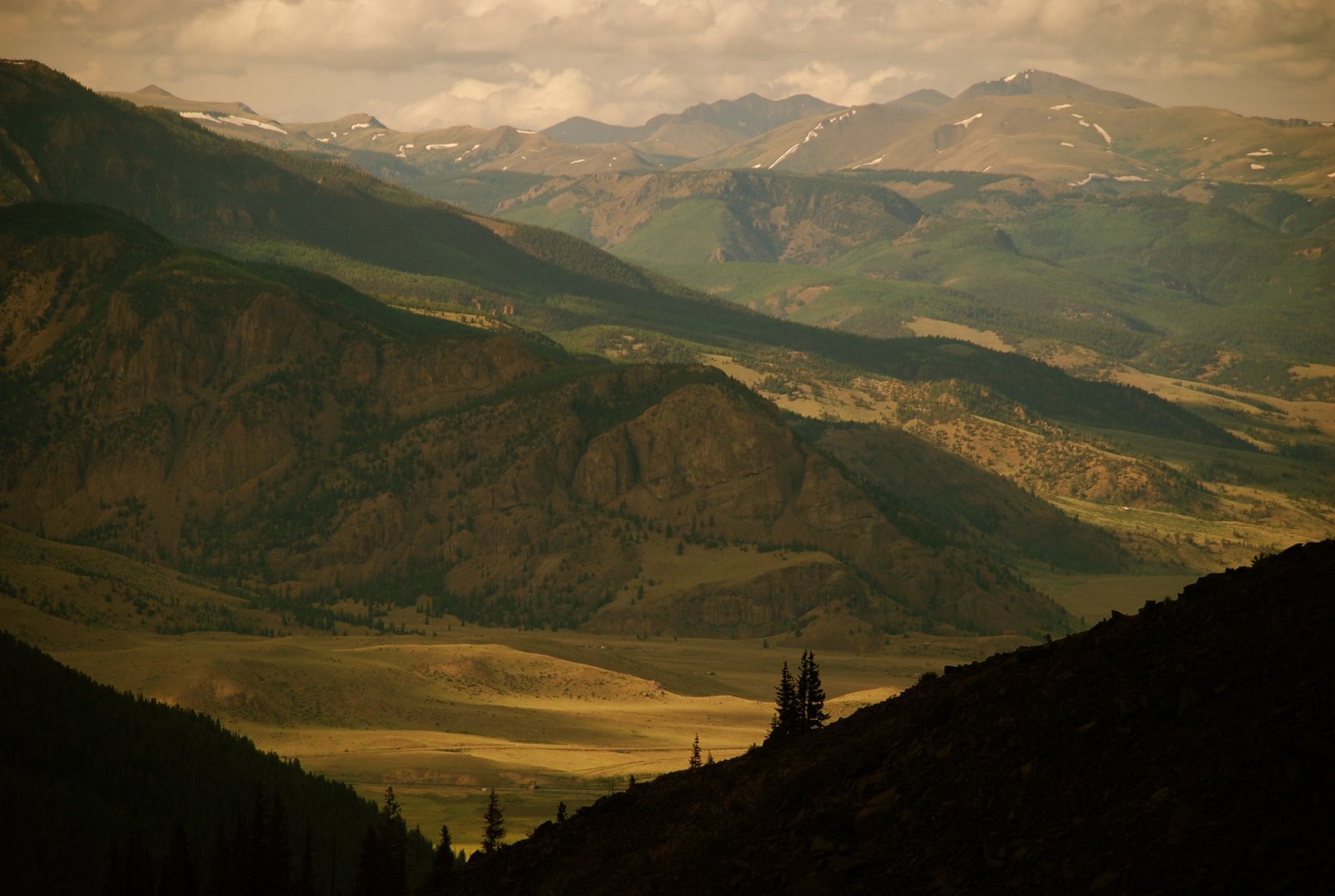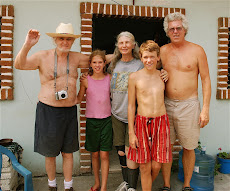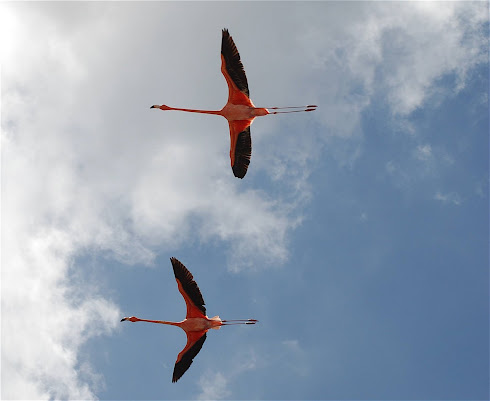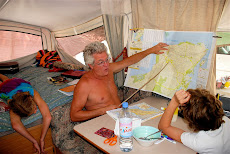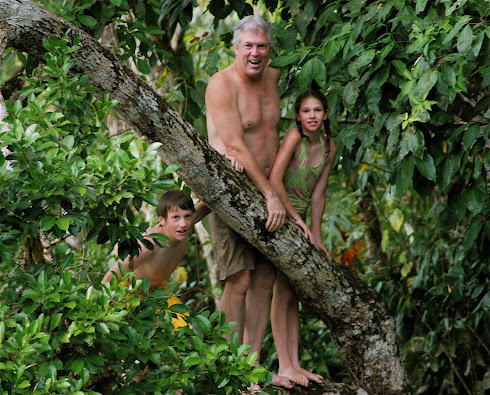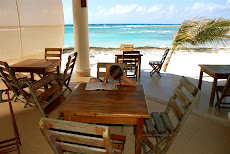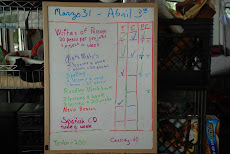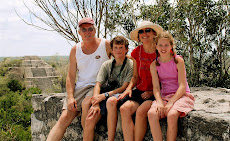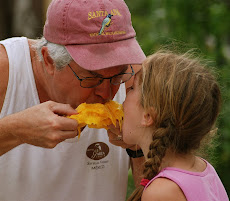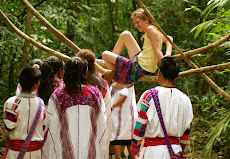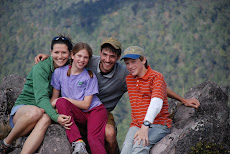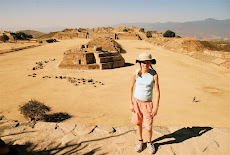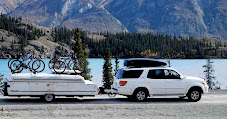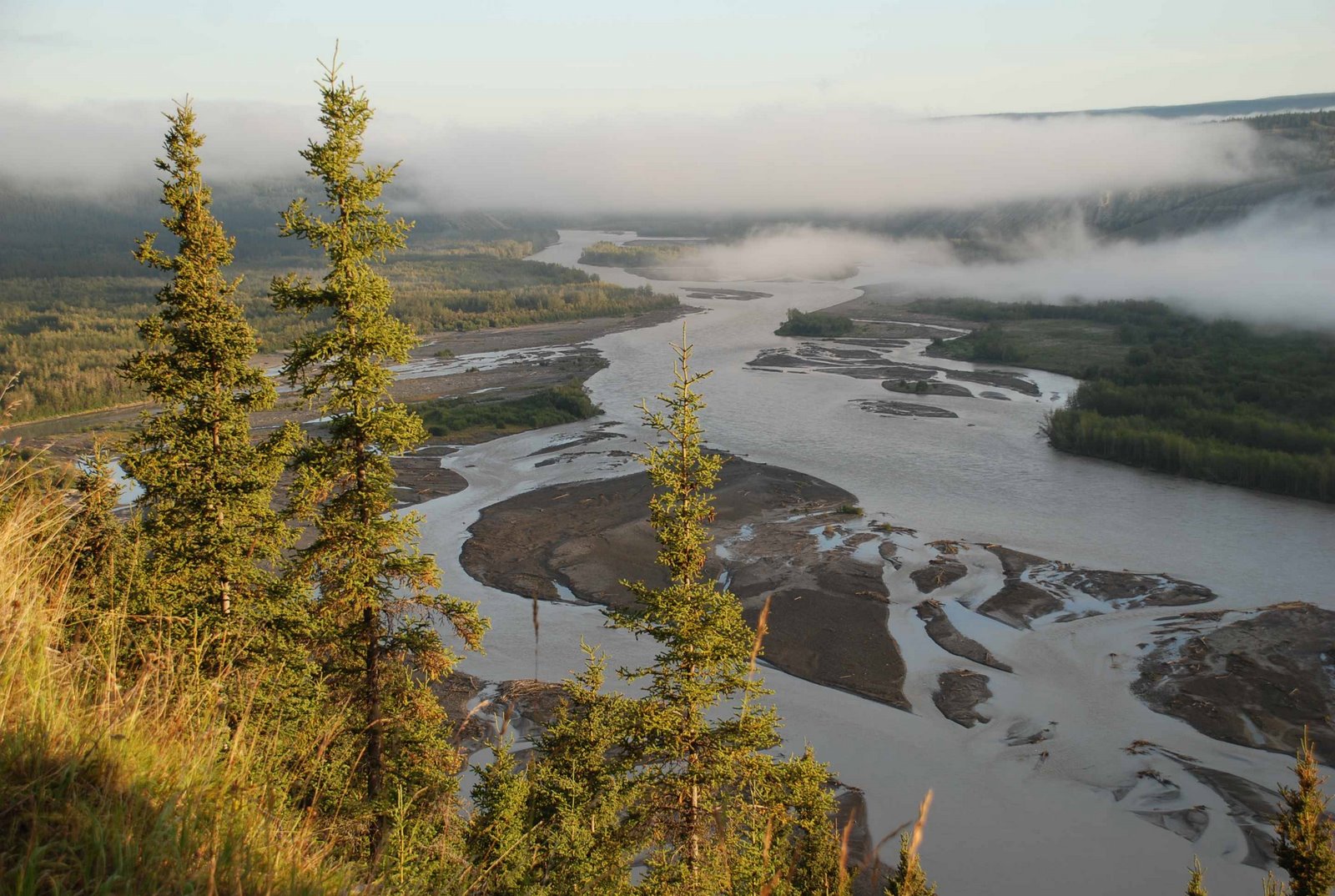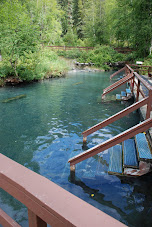The view west from the homestead
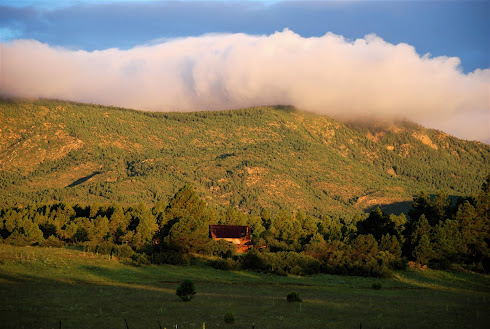
Sweet Chance
Tuesday, October 30, 2007
Boulder Colorado
HAPPY HALLOWEEN! We have settled merrily into Boulder Colorado and are staying with our friends Maria, Tim, and little Celia. Boulder was an odd place to end up at for the World Series, and we quietly changed to our new Iowa license plates the day we got here. Cassidy is sporting a new Colorado Rockies hat and is very proud of it. He was actually so depressed the Red Sox swept the Rockies that he launched himself off his skateboard at top speed and sprained his wrist. Poor guy. How bout those Red Sox?
We are enjoying living inside and are staying in Maria's downstairs abode. We realized that our 60 pounds of Halibut and Chinook salmon was actually NOT frozen when we arrived, and Tim's amazing culinary skills produced all sorts of yummy meals we couldn't pronounce (or spell). Chris smoked the rest of the salmon today and it is soooooooo yummy. We are wondering if we will burst the tires when we start traveling again with all our eating. We'll see!
Cassidy is a cowboy for halloween with a hankerin' to be moseying, and Teslin is a witch with a fabulous purple shiny robe and black witches hat. We just went to the Munchkin Masquerade on the Boulder Mall......oooooeeeeee....bit crowded! We were glad to mosey out of there. Alot of cute little tots though.
Well have a great Halloween everyone! Tata, Anny
Monday, October 22, 2007
Yellowstone Chronicles- October 22, 2007

We stopped at the Mammouth Hot Springs Ranger Station at the start of our drive to check on recent sightings of large predators and heard that there had been both wolf and Grizzly sightings in both the Hayden and Lamar Valleys close to us. We slowly drove the entire route across the upper park to the Northeast Entrance which was beautiful with several hundred bison-probably totaling over 1000 along a 20 mile stretch- grazing and moving very close to the road. We had to stop numerous times whenever a group of them decided that the highway was where they wanted to walk. They would just walk on both sides of the car, looking in our open windows as they passed, snorting, keeping the youngsters in line as they moved to other meadows for grazing. We finally turned back and headed toward home at 4:30 in order to catch the last Red Sox game-priorities you know!! Soon after this, we saw a large herd of Elk moving single file down toward the river close to us, some 60 total with a bugling large male in the rear of the group. They must have stretched over300 yards as they moved along in the late day sunlight. We had to stop and watch and listen of course before we continued west through the Lamar Valley. Five miles down the road, we came across a large grizzly some 100 yards off the road walking through a meadow. We stopped and set up our scope and just watched him amble slowly in front of us for some 8-10 minutes. He was quite majestic with a huge hump. He was within a mile of where we had been debating hiking several hours earlier but both Anny and I both felt too much like prey as we checked out the trailhead through some wooded areas and opted to do car vistas instead. We were quite happy and excited after this and continued on homeward across the Hayden Valley. We decided on one final stop at an overlook where we had heard what sounded like wolves 2 nights earlier and where 6-8 wolf spotters had set up their scopes. When we got out of the car, we knew that something was up as everyone was very excited and pointing out several objects down in the valley below us. We grabbed our scope and binoculars and joined the group to see what they were watching. Sitting right across the valley was a pack of 12-15 wolves, warming in the late afternoon sun on a large grass covered hillside, some 800+ yards in front of us. Also in view were 3 grizzlies, one some 300 yards up the hill from the wolves, 2 others in a creek bed some 3-400 yards to their west. We watched as the grizzly above the wolves came slowly down the hill-it appeared that neither he nor the wolves knew the other were there- until he came within 10-20 yards of where they were laying. Suddenly, all of the wolves were up and surrounded the grizzly as he veered west from the path he had been on. They didn’t appear to want to attack him but many came close enough to him to nudge him with their noses. He would start and stop every few minutes, one time standing up on 2 legs to either look around or make a statement-we didn’t know which. At this time, we noticed that the other 2 grizzlies seemed to know something was up and started to cover the ground between them, moving toward the lone grizzly and the wolves. The light was starting to fade fast now and it was harder to see them in the scope. Our last view of them was the lone grizzly moving toward us on a game trail with wolves behind and flanking him with the other 2 grizzlies gaining ground some 100 yards away from this group moving toward them. We finally decided to go home and will go back today to the Ranger Station to see what may have happened after we departed. It was an unforgettable experience-WOW!!
Chris
Saturday, October 20, 2007
Wimpy, Wimpy, Wimpy

October 20th, 2007
Gardiner, Montana
We have temporarily fallen from the ranks of die-hard campers. This is night #6 in a motel. It is 38 degrees and rainy and our pop-up is parked outside the door. It is time to go South, but we love the mountains so much, it is hard to leave. This is an ideal time to see Yellowstone. The elk are still bugling and moving down from higher elevations to lower meadows. The mule deer and Big Horn Sheep are also on the move, and wolves have been sighted fairly frequently in the Lamar Valley in the North. The snow and sleet help with having the park to yourself ( kind of!).
When we were at Mammoth Hot Springs visitor center, Cassidy ran inside and told us that there were elk bugling in the parking lot. We went outside, and sure enough, there they were, bugling. An enormus bull had a herd of about 30 females and calves, and there was another male who was nearby with only 6 females and no calves. There was also a single male that stood on the edge of the area. The largest herd was spread over the grass and in the road around the buildings of Mammoth Hot springs. The bull was quite agitated by the presence of these other males. (I'm sure the cars going by didn't help much). It was quite a scene. The other 2 bulls would bugle and try to attract females away from the larger herd. When any of females strayed from the group, the bull would run over and nudge them back. The two outside bulls did not challenge the big guy more than the occasional bugle. There were no head on confrontations. We had always wanted to see an elk bugle, but Wow! Quite in the middle of things!
We spent the whole day driving and hiking in Yellowstone. The biggest concentration of animals we saw was right near the visitor center. We saw alot of Bison.....they are so huge! We read that the Bison in Yellowstone are descendants of the original critters that were here before the white man slaughtered the population in the late 1800's. I thought they had been reintroduced as all the other bison have been that we saw in Canada. It is exciting to know that some have survived.
The weather was windy, wet and cold, and a mixture of rain and snow. Some places we drove through had 2 inches of snow already (4-9 inches of snow are expected by the end of today). We walked to a number of geysers, but got so wet and cold, we had to cut it short. We saw Old Faithful blow her steam, and hoped to see Steamboat Geyser erupt (the last eruption was in 2004, but we were feeling very lucky). Steamboat Geyser is the tallest one in the world and blasts over 300 feet when it goes. Alas, it only spurted 10 to 15 feet every few minutes. The coldness created a surreal look to the entire geyser basin......very beautiful. At the visitor center, we watched a film on Yellowstone and Dana Eldridge senior was in the introduction in his National Park uniform speaking for the Cape Cod National Seashore. It lasted about 5 seconds and was over before I realized it was him. Yay Dana!!!!
Today is a repeat of yesterday's weather and we are enjoying hanging out in a warm room. Cassidy and Teslin are doing Math's Mate, Chris is watching the Iowa Hawkeye's get slaughtered by Purdue, and the park entrance is a mile away. We are eagerly awaiting tonight's Red Sox game.....it will be interesting to see who goes on to play the Rockies, since we will be in Colorado for the World Series. Oh Boy!!!
Cassidy and Teslin had a great time the last two evenings with a group of kids from Helena, Montana. They had two different 2 hour games....capture the flag and tag. The kids left today, the Hawkeyes are losing, the sleet is howling sideways outside, and Cassidy fears if the Red Sox lose tonight, he will feel "a little depressed". Teslin says capture the flag was the most fun.
Welll......that's all from the Roving Ruges for today......tata! Anny
Thursday, October 18, 2007
Cassidy’s Bird Report –October 17, 2007

by Cassidy Ruge
Hello all birders! I’m sorry that I haven’t written lately, but I haven’t gotten to it because there is so much to do. I have seen a lot of birds lately on the Northwest coast and am a little sad to leave the northwest both because of the birding and because I had a very good time with family (Diane, Ray and Sarah Hazen). But I am excited to move onward on our adventure and go south to Mexico.
There were a lot of birds I saw in northwestern Washington on the Olympic Peninsula. Among them was the Varied Thrush, which I saw in the Hoh Rainforest on the other side of the peninsula. I also saw a lot of Life Birds at Diane and Ray’s including Chestnut-backed Chickadees and Steller’s Jays. I am very excited to get to Helena and go birding there. I have seen many life birds on our adventure, 41 in all. My dad bought a Thayer software CD for about 40 bucks which is a pretty good price for birding software. The CD has quizzes, custom lists and a lot more. Well, I’ll try to remember to write another “bird report” if I aren’t birding or doing something else.
Bye for now!
Cassidy
Why is the Pacific Northwest so green??

October 15, 2007
You know what? It rains ALOT! The Hoh rain forest in the Olympic National Park receives 115 inches of rain a year, Olympia, WA receives 56 inches, Massachusetts 40 inches and Tucson 12 inches a year. This is according to a national weather site on the Internet. I think I vaguely remember Diane telling me Shelton, WA receives 86 inches of rain a year. Needless to say, our noses are moist, and we are not troubled with dry buggers. As it was, when we arrived from B.C. and set up our pop-up, it was so moldy that the canvas above our beds was a grey-black. Yech!!!! Chris scrubbed like a pro with chemicals we can’t name and it smells much better now. Since then, it has been set up in Shelton and rained upon fairly frequently. The day we left was raining and so it lies behind us, folded and damp. Does this road lead to Tucson?
We have spent the last 10 days based out of Diane and Rays' 5 star camping facility in Shelton, WA. Shelton is about 30 minutes North of Olympia. (I have to say Muchas Gracias to all friends and relatives who have settled in awesome spots and who put up with the likes of us!) We had a great visit with them and my cousin Sarah.... explored Olympia a bit---awesome Farmer's Market, complete with Habanero chocolates, venison jerky, and live music (my favorite was the German Polka band we heard the first time we went....they were a real crowd pleaser. All sorts of flavorful folks were up dancing with their rain coats on). But mostly we ate. Wonderful food......Diane is a great and generous cook and we all were pampered and padded (especially when Ray did the dishes after!) Sarah proved to be a great inspiration for Cassidy’s and Teslin's home school, and previously groaned about workbooks were happily completed in her presence. We decided it was the ABP problem (Anyone But Parents) but to Sarah's credit, she really has a knack for helping kids.
We took a 3 day trip up the Olympic Peninsula to see Olympic National Park . We left our pop-up at Diane and Ray’s and actually stayed in motels. We felt like wimps. But you know…..50 degrees and rainy is not inspiring tent weather. We did a 2 1/2 mile hike through Old Growth forest out to Olympia Hot Springs, an undeveloped set of pools in the Park. That was great....the pools were a bit shallow, the bottom got stirred up easily, but nonetheless, they were exotic and lovely. We didn't get quite enough hot springs so we spent the night at the Sol Duc Hot Springs further west. They were developed and had the feeling of a fancy past, now a bit run down. The Springs are nestled in between 2 ridges and there is a great Native legend about dragons that accounts for not only the springs, but the moss that carpets the rain forest. I copied this from a Sol Duc website…
“The Quileute Indians called it 'Sol Duc' - a land of ‘Sparkling Water'. According to Indian Legend, long ago a dragon lived in the Soleduck Valley. One day, he met another dragon from nearby Elwha Valley and the two proceeded to fight over their land. During their fight, they cleared the timber above the treeline and left bare areas that can still be seen today.
The dragons also lost some of their skin, which is hanging in the trees and clinging to the rocks of moss lichen. The two fought for years and were an equal match. When neither dragon could win the fight, they crawled back to their caves and cried. According to legend, the dragons' hot tears are the source of the Sol Duc's Hot Springs.”
October 16, 2007
Now we are winding through Idaho on I-90. It is lovely and actually sunny. It’s in the 50’s and we hope to set up in Missoula tonite, then check out Helena tomorrow. We just came through a pass with Larch trees bright yellow amongst other dark green conifers. Larch are an unusual pine tree and are actually deciduos and loose their needles each year. It is especially beautiful since they are the same shape as the pines around them….I’ll see if Chris can post a picture. We will stay up in Montana/Wyoming until we get to the point where we can’t warm up during the daytime. That’s always a sure sign you are too far North (or need a house!). The next few days have a pretty nippy forecast, but it is below normal for now, so we are optimistic.
We have decided not to come East and get Little Bear as Chris wrote in the last blog entry. It has been a long hard road trying to find him a good home and a family from CT came forward and really wants to adopt him permanently. We are working out the details, but they have a similar family make up as ours, with 2 older kids (12 and 14), a nice big fenced in yard and wanting a home- body dog. Little Bear's dilemna has been the hardest part of this trip…
Well…tata for now, Anny
Sunday, October 14, 2007
STAND UP AND PROTECT WOLVES!!!!
This is a Table that shows all the different Canis lupus family members.
These are all subspecies of the Gray Wolf, Canis lupus.
Arabian Wolf -------------------Critically endangered ---------Canis lupus arabs
Artic Wolf --------------------------------Stable --------------------Canis lupus arcos
Caspian Sea Wolf ----------Endangered, Declining ------------Canis lupus cubanensis
Dingo ---------------------Vulnerable, (pure breed) ---------Canis lupus dingo-
Domestic Dog ----------------------------Stable -------------------Canis lupus familiaris
Egyptian Wolf --------Critically Endangered, Unknown --Canis lupus lupaster
Eurasian Wolf ---------------------------Stable ----------------------Canis lupus lupus
Great Plains Wolf---------------------- Stable------------------- Canis lupus nubilus
Italian Wolf----------------------- Endangered --------------Canis lupus italicus
Mackenzie Valley Wolf -----------------Stable ---------------Canis lupus occidentalis
Mexican Wolf -----------Critically Endangered -----------Canis lupus baileyi
Russian Wolf ---------------------Stable, Declining ---------Canis lupus commonis
South-East Aisan Wolf ----------------Stable -------------------Canis lupus pallipes
Tundra Wolf -----------------------Stable -----------------Canis lupus albus
Eastern Timber Wolf -----------------At risk ------------------Canis lupus lycaon
Iberian Wolf ---------------------------Stable ----------------Canis lupus signatus
Himalayan Wolf -----------Critically endangered -----------Canis himalayensis
Indian Wolf -------------------------Endangered ------------------Canis indico
Hokkaido Wolf ------------------------Extinct -----------------Canis lupus hattai
Honshu Wolf ----------------------Extinct ---------------Canis lupus hodophilax
My e-mail is fairyvet96@gmail.com
Teslin Marie Ruge, Age 10
Saturday, October 6, 2007
Little Bear returns to family

We have decided as a family that we need to have our dog, Little Bear, come back and be with us. We have been thinking of him alot and feel that he is our missing link here on the Road. We had hoped to place Little Bear with a foster family until the spring but it didn't work out and he has lived the past 2 months at a local kennel/boarding place in Granby. We finally decided that enough was enough and Teslin and I are taking a flight back this week to pick him up and fly him back to Seattle with us. We know that this will create its own set of issues for us as we hope to travel to Mexico in December for 2 months and will not take Bear for that stretch so will need to find a home for him during that period of time or have another long stay for him at a boarders-probably in the Southwest. Anybody with ideas for a foster home for him for this time in the Southwest, please send us an email. Thanks for any help/ideas with Bear.
Friday, October 5, 2007
Cool things!
Bore Tides: SURF'S UP!
Bore tides are my number one favorite discovery so far on this trip. A bore tide is a long lasting wave that is caused by an extremely large tide coming into a very narrow channel. There are over 60 bore tides in the world, but the one in Alaska south of Anchorage is the most dramatic (so they say). (There is one in China that can get up to 30 feet tall and travels almost 20 miles per hour--that sounds pretty dramatic too!). What is so amazing about the one in Alaska is that this wave travels for 40 to 50 miles down the coast and takes 5 hours to go from the mouth of the channel to it's end. Although there is a bore tide every day, the ones that are really impressive and surfable are the ones surrounding the full and new moons when the tide fluctuations are at their biggeest.
In Alaska this happens at Turnagain Arm, about a 20 minute drive South of Anchorage. The Turnagain bore tide is the only one in the far North, and is the most dramatic. It is surrounded by mountains and very accessible since the road down to Portage glacier parallels Turnagain Arm. With the right moon, the bore tide can be up to 10 feet tall and goes forever. The best chance to catch one of these waves is the 5 days around the full and the new moon. The wave itself is described as a "breaking wave", so you might not get tubed, but still....pretty cool, ehh?
DRUNKEN FORESTS:
Another cool, but potentially depressing subject is drunken forests. Up in the northern part of Alaska, much of the land is covered in permafrost. Permafrost is soil that remains below 32 degrees farenheit year round. Some permafrost has an active layer on it which melts and supports plant growth in the summer months. The permafrost below remains frozen. However, sometimes the layer below gets too warm and will melt as well, causing a depression to form in the permafrost. (This is caused by, say, a gradual warming process that leaves the ground above 32 degrees). The treees that are most often affected are black spruce (thin, spiky trees with very shallow roots). Their roots will gradually reach into the depressions in the permafrost and skew them to one side. This leaves some areas looking like the trees are all willy nilly and might have a drinking problem. It actually takes many years for the effect to take place.
One down side of this whole process is that other structures besides trees reside on permafrost. Around the globe, as tempertures climb higher, areas in the far north are experiencing sagging of house foundations and roads....basically, anything built on the permafrost. The melting permafrost also releases carbon and methane into the air. Considering the mass of Northern Canada, Alaska, Greenland and Iceland, a huge amount a permafrost will be affected. One big gassy, sagging area.
So that is the depressing part of it all. Drunken forests are a natural cycle. However, global warming is causing huge changes that are above and beyond natural.
And that's the truth Mr. President!
Well....that's it for today's fascinating facts. More later! Anny
Wednesday, October 3, 2007
Saturna Island-October 3, 2007

October 3, 2007
It’s early morning…. five to nine, and once again, I am sneaking some peace before the others wake up. Mostly I am sneaking the computer before Cassidy and Teslin come in and want to watch the special features on the Harry Potter movie we rented last night (yes…you can watch movies on a lap top…it might be the opposite of the movie theater experience, but suits us fine!).
We have now been in the islands off of Vancouver, B.C. for 2 weeks. The first night down here we met my folks, (AKA Grandma and Grandpa, Gramps, Grams, and Mary and Paul Bosley). We had a great reunion in the hotel’s eatery in the morning and despite everyone’s exhaustion from the previous days follies, we went off to the Vancouver Aquarium for the afternoon and then caught a ferry to Saturna Island in the evening. Some dear folks, Nell and Owen Dykstra have a cabin there and said we could pop-up for free as long as we like. Since there is no camping permitted on Saturna this is a great thing (it’s fine to camp on your own property—many folks do). Grandma and Grandpa stayed in the cabin and we snored away in the comfort of our Big Poppi. Cassidy and Teslin took turns sleeping in the cabin…. big stuff.
We spent 4 days wandering around. The sun blessed us with unbelievable weather, and we went to East Point (Cassidy called the little islet offshore Life Bird Island). Black Oystercatchers, Surfbirds, Heermann’s gulls, Brant’s cormorants, Harlequin Ducks, Black Turnstones, Common Loons, to name a few! It was also tide pool heaven and naptime for many seals. No orcas yet…except for the distant fins we saw on the glacier tour in Seward.
We also took a trip to the highest point in Saturna (which is actually the highest peak in all the gulf islands) to Warburton Pike. Amazing views from there. It is a very steep slope down to the water, so it allows for great views of the water, inlets, boat activity and birds. The best part were the ravens that were playing on the thermals. Incredible, really! One would land in a pine tree and get a cone and then take off high. Another would follow and once they were high above, the first would drop the cone by swinging it’s feet up in front of it’s head and launching the cone into the air. The second would catch it, complete with dives and flips and incredible maneuvering. The pair would do this until they were almost back down to the ground and then it would all start over. It looked like a courtship dance…. but in September? We think they were just playing, since many of them seemed to be doing it. We watched them for a couple hours. Wow!
From Warburton Pike Chris, Grandma, Teslin and I walked down towards the winery on the coast. Well…we followed a very old road through the woods that we thought was a trail. Judging by the amount of trees we had to skirt, we might have missed it! We eventually met up with Gramps and Cassidy and settled down to some wine tasting. That was fun, a bit hurried, but fun. (A great Pinot Gris).
After a few days in Saturna we headed over to Vancouver Island. It is such fun to go places by ferry. The lifestyle out here seems much more peaceful, especially on Saturna. Vancouver Island is quite built up and touristy where we went. Beautiful, but well trodden upon. We spent a night in Nanaimo en route to Tofino which is on the West coast of Vancouver Island. We rented a spectacular place for 3 nights, the Tofino Chalet. It is a very modern, glass-rich place perfectly placed in some ancient red cedars on a bay with mountains with the Tofino harbor way out in the distance. Huge tides, so that at low tide, there was a giant mud flat with some saltwater creeks running through it. Great birding. Cassidy and Teslin put on their knee high boots and tried to explore the mud flat, but it was a miracle they got back out. It was boot sucking, children eating mud. They looked like creatures from the deep when they got back and smelled like it too. Grandma hosed them off and they seemed to loose their appetite for further mud flat exploration. It was such a gorgeous spot…. I could feel myself get softer with each night.
On their last day, Grampa, Cassidy, and Chris went out fishing for 5 hours and caught nearly half the sea. I’ll have to let one of them explain since I was busy having a girl’s day out. THAT was great…3 generations of women. We dawdled, and drank tea, and had an Empress moment on the huge cedar stump facing the water. An empress moment is a tea ceremony involving a very special tea bag donated by Jane Klimshuck which was “given to them” when they went to the Empress house for high tea in Vancouver Island—the high tea cost them over $200 and they each received a parting gift of a tea bag when they left! It also involves nose rubbing, kissing, and putting foreheads together for a group breath. Delightful, needless to say. We also made it down to the beach where only 2 generations went flying naked into the waves. (The middle generation is a sissy when it comes to cold water). Ahh the Pacific. I have to say, it was NOT balmy weather! I was very impressed with their grit. I even donated one of my layers for them to dry off on. Grandma and Teslin were both giddy with delight and we had a great time on the trail to and from the sea through old growth rain forest.
We had a teary goodbye the next morning. It was very special to visit and reminds us how many dear connections we have left in the East. It also reminds us how much we want others to come play! We spent one additional night at the Chalet before returning to Saturna. The weather closed in with our return, and has been cool and drippy since. On the ferry back (we took the long one and arrived at 11:30pm) we listened to Harry Potter book #1 again…it opened up the cauldron of Hogwarts---unstoppable--and we rented the first 3 movies, one a day since our return. We make popcorn, have spritzers and beer, and all squish on a couch and peer into the laptop. Life was never so good.
Today we leave Saturna for the southlands. We are going to descend on Diane and Ray and Sarah Hazen near Tacoma and have more family and fun. We also hope to go to the Olympic Peninsula for more rainforest (and hot springs) if we can dry off the mold that is growing so far. We are also aware that the Red Sox made the play offs and hope to actually see a game some day before the season is over. Ta Ta for now! Anny
Monday, October 1, 2007
Drip Drip Drip

October 1st, 2007
Slowly slowly, ever so delicately, we are losing our marbles. ..a spell of too many mice in box. Drip drip drip. The cabin is very small, perhaps a bit bigger than the pop-up and it has a real bathroom--- amazing. Drip Drip Drip. 40's and rainy, kids arguing. Saturna is lovely and quiet and wet. Today it is mostly quiet and wet. The slugs are having a fabulous time and we are trying to avoid smooshing them. Cabin fever makes for hot feet. Tapioca pudding and Yukon Red....another game of super scrabble must begin soon.
Pacific Salmon by Cassidy

PACIFIC SALMON (Oncorhynchus)
Description: There are 5 different species of pacific salmon. The Dog (Chum) Salmon, the Pink (Humpy) Salmon, the Red (Sockeye) Salmon, the Silver (Coho) Salmon, and the King (Chinook) Salmon. The weight in pacific salmon varies from species to species. The smallest kind, the Pink only gets to be 7 pounds, occasionally reaching 11 pounds. On the other hand the Chinook weighs between 3-80 pounds. Pacific salmon also differ in color. The Chinook has a speckled back with a silvery belly and a side. Coho are very similar to Chinook in appearance but have a more silvery side and belly and less speckles on the back. Sockeye Salmon are dark in color overall and have black surrounding the eye and a dark head. While spawning, Sockeye are a brilliant red and have an all green head. Pink Salmon have a hump while they are spawning giving them the name Humpy. In appearance they look a lot like Sockeye but are generally lighter in color. Dog Salmon have a very white belly and a black stripe along the side and a green splotch near the head.
Feeding: Pacific salmon eat a variety of fish, crustaceans and plankton while in salt water. My dad and I went on a charter boat and caught 8 Chinooks and 6 Halibut. When we opened the bellies of the salmon, we found whole herring in most of their stomachs. I don’t know exactly what fish the other species of salmon eat, but I think they eat smaller fish such as Anchovies and Char. Pacific salmon eat a lot while they are living in the ocean. When they’re getting ready to spawn they don’t eat at all because of instinct. The only way to catch one while its spawning is to snag it, but in most places that is illegal. I once accidentally snagged one while I was fishing for Dolly Varden. Young Chinook Salmon are called feeders their first year in saltwater. I went fishing for them in Tofino, Vancouver Island with my dad. (The same trip I had caught all those halibut).
Range and Habitat: Pacific Salmon are spread out over a lot of places. All five species are found all over British Columbia from the Kootenay Rockies to the Caribou Chilcotin Coast. in freshwater and saltwater. Most of the salmon are found in different parts of Alaska too. I caught both Sockeye and Silver Salmon in Alaska. (Silver in Homer and Red in Chitina). They also live all the way down to Washington and California. Salmon live part of their life in freshwater and part in saltwater. They are born in freshwater in streams, rivers and lakes and they stay in freshwater for about 1-2 years and then go into the sea. They stay in the ocean for 1-8 years before going back up the streams they were born in (or released in if hatchery fish) to spawn and die.
Life cycle: Salmon travel great distances to their spawning grounds to lay their eggs and for males to fertilize them. They travel upstream from a mile up to 1,800 miles in rivers and streams. Chinooks and Reds travel the farthest, Chinooks traveling up to 1800 miles in the Yukon River and its tributaries! Chum, Coho and Pink spawn closer to the ocean because they aren’t as good travelers. When they reach their destination, the males will guard the female and fertilize the female’s eggs. The males are very protective of their females and will chase any other fish or salmon near the female. Other fish such as Dolly Varden will try to steal the salmon eggs and eat them. Naughty little buggers!!! Once the females have laid their eggs and the males have fertilized them, the salmon start to decompose, losing their color and eventually they will die. The eggs remain under gravel during the winter incubating and then going through the stages called “eyed eggs” and “hatched alevins”. The new “fry” emerges from the gravel in May and June and feed and grow here for up to a year. The next phase of their lives is called “fingerlings” where they go back to the ocean, eating a lot and growing rapidly. After spending 1-8 years in the ocean, the cycle is repeated.
Hatcheries: Although most fish fisherman catch are wild, some of the salmon come from hatcheries. There are a lot of hatcheries in most Western states and provinces in the U.S. and Canada. You can tell the different between hatchery and wild grown ones by looking at their adipose fin. Hatcheries cut off the adipose fin and also put a microscopic piece of metal on their precious snout in all their salmon before letting them into the wild. In oceans or streams, the salmon’s adipose fin is still on their little backs, (unless its been bitten off already) and they don’t have a lunk of metal on their snout! There is a program in Tofino that is, if you catch a hatchery- run salmon, you can send the head of the salmon to a Salmon Research group with a piece of paper. The fun thing about it is that the people in the Salmon Research groups will tell which hatchery the salmon came from and where the salmon had gone over the years. My dad and I went fishing in Tofino and happened to catch three of those hatchery raised salmon on a charter! We wrote down on a piece of paper the date, our name, when and where we had caught the fish, ect. Then we tied 3 strings to the heads of all the salmon with the pieces of paper. The paper said that they would send us the salmon’s life history in 2-3 months time.
Conclusion: Pacific Salmon are a very interesting subject to write about. I chose to research and write about pacific salmon because I wanted to learn more about them and write about salmon. I also wanted to research them so I could see which species are in trouble. I enjoy fishing for salmon and learning about them.
Fun Facts:
1. My mom is grossed out of the pictures of me holding a salmon because she said they were too bloody and that I should have cleaned up the fish!
2. The nests of pacific salmon are called Redds.
3. Dog Salmon get their name by the 2 canine teeth they develop while spawning.
By Cassidy Ruge
September 30, 2007
